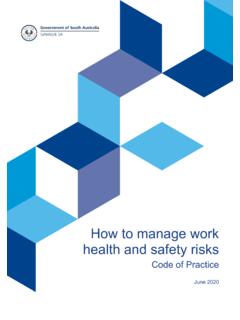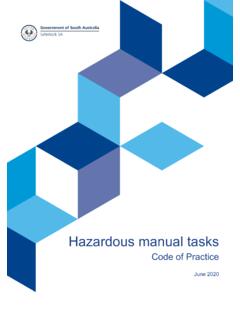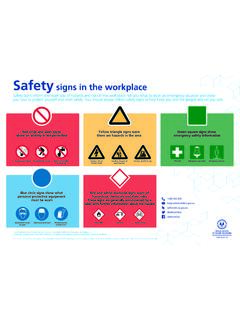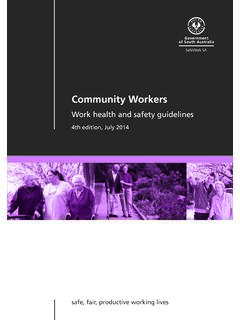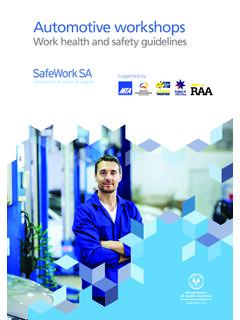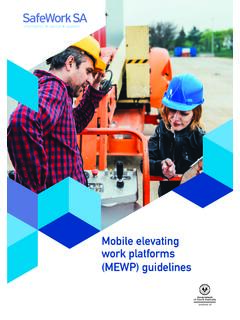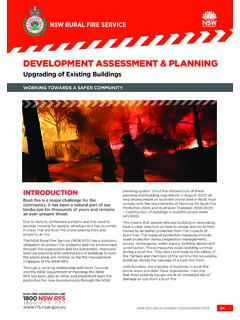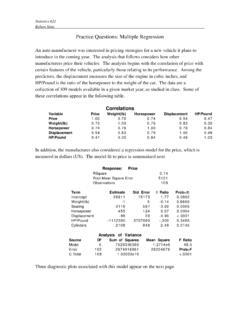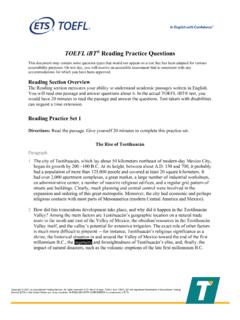Transcription of Managing the risk of falls at workplaces - SafeWork SA
1 Managing the risk of falls at workplaces Code of Practice June 2020 This code is based on a national model code of practice developed by Safe Work Australia under the national harmonisation of work health and safety legislation and has been approved under section 274 of the Work Health and Safety Act 2012 (SA), following the legislated consultation. This code of practice commenced in South Australia on the date it was published in the Government Gazette, 4 June 2020. Creative Commons This copyright work is licensed under a Creative Commons Attribution-Non-commercial International licence.
2 To view a copy of this licence, visit In essence, you are free to copy, communicate and adapt the work for non-commercial purposes, as long as you attribute the work to Safe Work Australia and abide by the other licence terms. Contact information Safe Work Australia | | Contents Contents .. 3 Foreword .. 5 1. Introduction .. 6 Who has health and safety duties in relation to falls ? .. 6 What is involved in Managing the risk of falls ? .. 9 Information, training, instruction and supervision .. 10 2. The role of designers of plant and structures .. 12 Eliminating or minimising the risk of falls at the design 12 Plant.
3 13 Buildings and structures .. 13 3. The risk management process .. 15 Identifying the hazards .. 15 Assessing the risks .. 16 Controlling the risks .. 17 4. Work on the ground or on a solid construction .. 20 Work on the ground .. 20 Work on a solid 21 5. Fall prevention devices .. 27 Temporary work platforms .. 27 Perimeter guard rails .. 40 Safety mesh .. 41 6. Work positioning systems .. 42 Restraint technique .. 42 Industrial rope access systems .. 43 7. Fall arrest systems .. 46 Catch platforms .. 46 Safety nets .. 47 Individual fall arrest systems .. 47 Vertical anchorage lines or rails.
4 52 Double lanyards .. 54 8. Administrative controls .. 55 No go areas .. 55 Permit systems .. 56 Organising and sequencing of work .. 56 9. Ladders .. 57 Portable ladders .. 57 Fixed ladders .. 61 Ladder maintenance .. 62 10. Emergency procedures for falls .. 63 Appendix A Glossary .. 66 Appendix B Referenced documents and further reading .. 70 Appendix B References and other information sources .. 72 List of amendments .. 74 Managing the risk of falls at workplaces Code of Practice Page 5 of 74 Foreword This Code of Practice on how to manage the risk of falls at workplaces is an approved code of practice under section 274 of the Work Health and Safety Act (the WHS Act).
5 An approved code of practice provides practical guidance on how to achieve the standards of work health and safety required under the WHS Act and the Work Health and Safety Regulations (WHS Regulations) and effective ways to identify and manage risks. A code of practice can assist anyone who has a duty of care in the circumstances described in the code of practice. Following an approved code of practice will assist the duty holder to achieve compliance with the health and safety duties in the WHS Act and WHS Regulations, in relation to the subject matter of the code of practice. Like regulations, codes of practice deal with particular issues and may not cover all relevant hazards or risks.
6 The health and safety duties require duty holders to consider all risks associated with work, not only those for which regulations and codes of practice exist. Codes of practice are admissible in court proceedings under the WHS Act and WHS Regulations. Courts may regard a code of practice as evidence of what is known about a hazard, risk, risk assessment or risk control and may rely on the code in determining what is reasonably practicable in the circumstances to which the code of practice relates. For further information see the Interpretive Guideline: The meaning of reasonably practicable. Compliance with the WHS Act and WHS Regulations may be achieved by following another method, if it provides an equivalent or higher standard of work health and safety than the code.
7 An inspector may refer to an approved code of practice when issuing an improvement or prohibition notice. Scope and application This Code is intended to be read by a person conducting a business or undertaking (PCBU). It provides practical guidance for PCBUs, including those persons who design, construct, import, supply or install plant or structures, on how to eliminate, or if that is not possible, minimise the risk of falls from height in workplaces . This Code applies to all types of work and all workplaces covered by the WHS Act and WHS Regulations where there is a risk of a fall by a person from one level to another that is reasonably likely to cause injury.
8 This Code may be a useful reference for other persons interested in the duties under the WHS Act and WHS Regulations. How to use this code of practice This Code includes references to the legal requirements under the WHS Act and WHS Regulations. These are included for convenience only and should not be relied on in place of the full text of the WHS Act or WHS Regulations. The words must , requires or mandatory indicate a legal requirement exists that must be complied with. The word should is used in this Code to indicate a recommended course of action, while may is used to indicate an optional course of action.
9 1. Introduction falls are a major cause of death and serious injury in Australian workplaces . Fall hazards are found in many workplaces where work is carried out at height, for example stacking shelves in warehouses and retail outlets, working on a roof, unloading a large truck or accessing silos. falls can also occur at ground level into holes, for example trenches or service pits. Who has health and safety duties in relation to falls ? There are a number of duty holders who have a role in Managing the risk of falls in the workplace. These include: persons conducting a business or undertaking (PCBU) designers, manufacturers, importers and suppliers of plant, substances or structures officers workers, and other persons at the workplace.
10 Early consultation and identification of risks can allow for more options to eliminate risks and reduce the associated costs. A person conducting a business or undertaking WHS Act section 19 Primary duty of care A PCBU has the primary duty under the WHS Act to ensure, as far as reasonably practicable, that workers and other persons are not exposed to health and safety risks arising from the business or undertaking. This duty requires the person to manage risks by eliminating health and safety risks so far as is reasonably practicable, and if it is not reasonably practicable to do so, by minimising those risks so far as is reasonably practicable.
